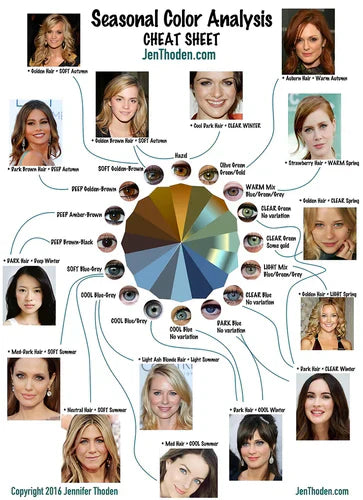Highlight your inherent beauty by finding the most flattering hues according to your skin tone, hair shade and eye color. Skip fleeting fads and discover what looks best on beautiful you—forever and always. For years, fashion stylists and makeup artists have relied on Personal Color Analysis as their special tool, and now you can steal their superpower and create your own personal palette.

HOW TO DETERMINE YOUR COLOR?
Recognizing your seasonal color is a great way to choose personal clothing colors that complement your natural skin tone and enhance your overall appearance. Here are some tips to help you determine your seasonal color:
-
Determine your skin undertone: Look at the veins on the inside of your wrist. If they appear blue or purple, you have cool undertones. If they appear green or olive, you have warm undertones. If you can't tell, you may have neutral undertones.
-
Identify your season: Based on your undertones and other physical characteristics such as eye and hair color, you can determine which season you fall under. There are four main seasons: Winter, Spring, Summer, and Fall.
-
Look at color swatches: Once you've identified your season, you can look at color swatches for that season to see which colors complement your skin tone the most. For example, if you're a Winter, you'll look great in bold and bright colors like fuchsia, royal blue, and emerald green. If you're a Spring, you'll look best in warm and sunny colors like coral, peach, and golden yellow.
-
Experiment with different shades: Within each season, there are different shades of colors that will suit you better than others. For example, if you're a Summer, you might look better in muted pastels like lavender and sky blue, rather than bright neon shades.
By following these tips and experimenting with different colors, you'll be able to find the perfect clothing colors that flatter your natural beauty and make you feel confident and stylish.
Best Online Resources:
MAIN COLOR TYPES

JUMP TO SECTION FOR BEST TYPE COLORS:
COLORS BEST FOR ANYONE:
BLACK AND WHITE!
Best Colors for Light Spring

BEST COLOR FOR WARM SPRING

BEST COLORS FOR CLEAR SPRING

BEST COLORS FOR SOFT AUTUMN

BEST FOR DEEP AUTUMN

WARM AUTUMN

DEEP WINTER

CLEAR WINTER

CLEAR WINTER

COOL SUMMER

SOFT SUMMER

LIGHT SUMMER

OUR FABRIC SWATCHES
How to recognize your color?
We developed three steps for demonstrating to you the procedure for scrutinizing yourself through the duration of twelve seasons. I have employed this system consistently over the years, however more recently I am executing a much more sophisticated structure. In spite of this, these three steps remain an ideal place to begin any account evaluation. Allow me to instruct you how. One must be aware that it's not always simple to identify a dominant attribute of someone's personality. For those cases, you need to use the approach detailed lower on the page - sometimes referred to as the “Tonal Method”. To start, examine yourself WITHOUT any cosmetics in optimal lighting conditions (but preferably natural light).
1. Determine your dominant characteristic.
-
Deep: Strong, rich, dark coloring
-
Light: Very light and delicate
-
Warm: Yellow-based colors, no blue undertones
-
Cool: Blue based colors, no yellow or golden undertones
-
Clear: Bright, clear colors, nothing muted or dusty
-
Muted: Soft, dusty colors; nothing bright and overpowering; often quite neutral in temperature and saturation.
2. Determine secondary characteristic
Choose either the warmer or cooler colors depending on your main feature. Consider, for example, whether using deep cool hues such as navy and burgundy suit you more, or if you look better in deep warm shades like brown and forest green.
Once you have determined if your dominant hue is "Warm" or "Cool", decide upon its saturation value. For instance, if your prime tone is "Warm" and it has a lively clarity to it, then you are described as a Warm Spring. However, if it has a more subtle look to it, then you would be categorized as a Warm Autumn. Deep, Cool Colors = Deep Winter Deep, warm colors = Deep Autumn Light, warm colors = Light Spring Light, Cool colors = Light Summer Clear, cool colors = Clear Winter Clear, warm colors = Clear Spring Soft, warm colors = Soft Autumn Soft, cool colors = Soft Summer Warm, light colors = Warm Spring Warm, medium colors = Warm Autumn Cool, medium colors = Cool Summer Cool, darker colors = Cool Winter
3. Test Drape Key Colors
If you have determined your dominant trait and are still a little unsure whether you lean toward cool colors or warm colors, then test these colors against your face with a swatch, a scarf, sweater, or the Face Flash Cards. While most seasons share colors from their “sister season”, there will be certain colors which will look best for one season over the other. Below are some of those colors for each dominant group:
Deep Autumn vs. Deep Winter Salmon Pink vs. Fuchsia Light Peach vs. Icy Pink Terracotta vs. Burgundy Light Spring vs. Light Summer Bright Coral vs. Deep Rose Camel vs. Cocoa Light moss vs. Aqua green Warm Spring vs. Warm Autumn Light Mango vs. Pumpkin Medium Blue vs. Jade Clear Red vs. Rust Cool Summer vs. Cool Winter Soft White vs. Pure white Lavender vs. Royal Purple Raspberry vs. True Red Soft Summer vs. Soft Autumn Blue Green vs. Olive Green Soft Fuchsia vs. Salmon Pink Burgundy vs. Mahogany Clear Spring vs. Clear Winter Warm Pink vs. Magenta True Green vs. Pine Green Clear Teal vs. Royal Blue




